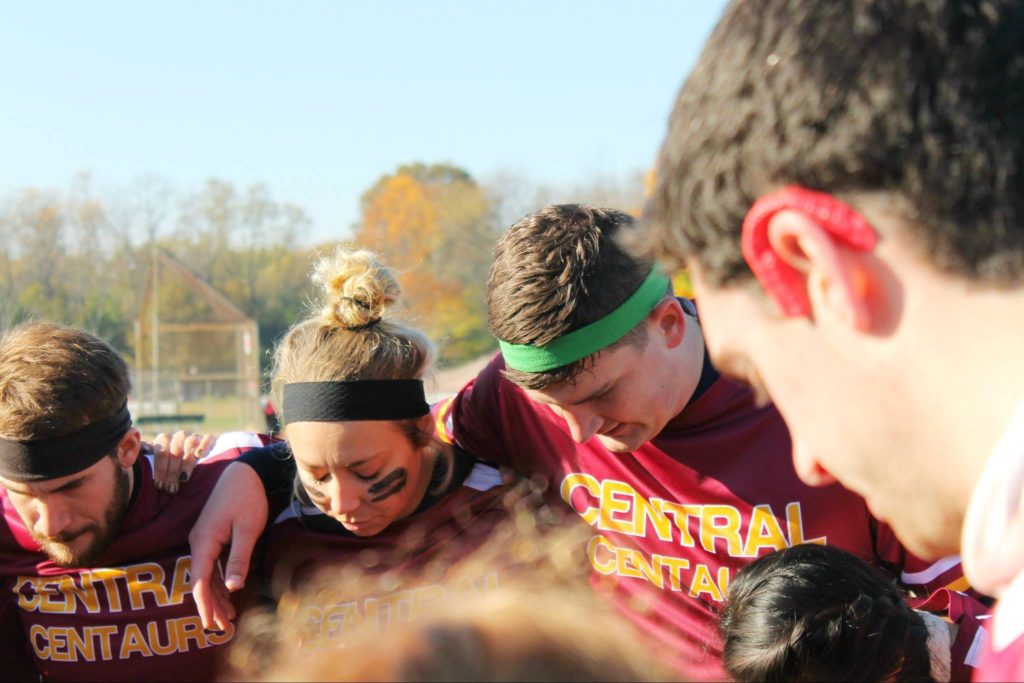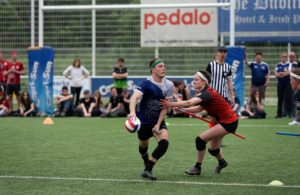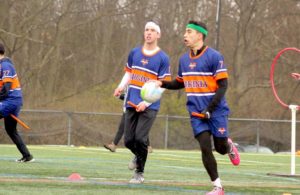- Rule, Britannia, no more?
- Unpopular Opinions: US Quadball Cup 2023
- Proven Contenders: University of Virginia
- Proven Contenders: Rutgers University
- Proven Contenders: University of Michigan
- Proven Contenders: Creighton University
- Different Perspectives: A Look Inside USA Ultimate
- Antwerp QC, Much of Belgian Core, Leaves Competitive Quidditch
March Madness: Play-In Round Recap
- By Ethan Sturm
- Updated: March 13, 2017
A major snowstorm may be heading up the East Coast, but don’t let that distract you from the fact that we are firmly in March, and quidditch March Madness is officially in full swing. The play-in round saw a mix of close matches and blowouts but, in the end, we had our brackets first eight casualties.
The Mid-Atlantic shucked the cold March climes and heated up in the tournament’s opening day, scoring three victories and two defeats. It was also a good round for some of quidditch’s oldest, most-storied programs, as Michigan State University and the University of Minnesota both moved on.
Which teams struggled to advance and which waltzed to the main bracket? Let’s break it all down.
No. 8 University of Minnesota over No. 9 University of Virginia
Result: 82 percent to 18 percent
While this one garnered some debate early, in the end, it was Minnesota’s value to expansion in the Midwest—sustaining a massive intramural program, a school program and two community teams—that saw the program through. A Midwest Regional Championship title in 2015 helped matters as well. And we cannot forget that before it was the Baylor Zone, it was Minnesota’s “Three Trees Defense.” Virginia got its fair share of credit for consistently strong on-field performances, including a Sweet 16 run at World Cup 8 and the referee efforts of Erik Morlock, but in the end it wasn’t nearly enough to overcome.
No. 10 University of Rochester over No. 7 Oklahoma State University
Result: 82 percent to 18 percent
Two powerhouses of the opening round found themselves head-to-head but our readers and our staff agreed, sending Rochester comfortably through. Oklahoma State’s case rested heavily on the backs of Hayden Applebee’s on-field play and Amy Kimmel’s tournament direction, but it was an uphill battle to take on Rochester’s dynamic duo of Devin Sandon and Lisle Coleman; Sandon, whose contributions in the sport over the past six years include player accolades, snitching and volunteering for USQ in areas of gameplay, and Coleman, who serves as both the regional director for USQ’s Northeast and human resources director for MLQ. Rochester was also much of the weight behind the Rochester United squad that went all the way to last year’s US Quidditch Cup 9.
No. 9 Sam Houston State University over. No. 8 University of Southern California
Result: 79 percent to 21 percent
This matchup barely needed a Sam Houston resume, as USC’s complete lack of one in recent years was enough to lose on its own. USC has not been to a World Cup since World Cup VI and did not even attend the West Regional Championship this season. For a team that sat No. 1 nationally in The Eighth Man poll within the confines of this contest—that is, during the World Cup VI season—it has been a long, hard fall.
No. 7 Rutgers University over. No. 10 Marquette University
Result: 59 percent to 41 percent
While Marquette has produced the on-field highs between these two, it’s their lows that likely pushed the Scarlet Knights on to the next round. Marquette’s World Cup record, which includes a World Cup VI morning where they showed up without their whole team and a World Cup 8 where—at the last minute—they chose not to show up at all, makes their Midwest Regional Championship title and lead over Middlebury at World Cup V seem like a long, long time ago. Rutgers, meanwhile, has been a team of the present, with star Lindsay Marella earning a spot on Team USA 2016 and the team grabbing the No. 1 seed at the 2015 Mid-Atlantic Regional Championship, a semi-final spot at 2016 Mid-Atlantic Regionals Championship and a trip to bracket play at US Quidditch Cup 9. Maybe recency bias is at work, but it’s hard to imagine that even a decent history in the past four years for Marquette would have seen them through.
No. 9 LSU over No. 8 RIT
Result: 80 percent to 20 percent
It was a nightmare matchup for RIT, who had to go up against easily the most storied program in the play-in round. Shane Hurlbert is an incredibly strong mark on RIT’s resume, but Brad Armentor basically cancels him out in all facets. And from there, things are not nearly as close. Sarah Kneiling has been a massive presence in quidditch volunteering since before most of us knew quidditch was a sport and joined Brad Armentor on Team USA 2012. Melissa White also turned down a Team USA offer while making a name for herself as one of the premier female players in the sport as both a chaser and beater. And nothing RIT has done on the pitch can come close to one of the sport’s most historic upsets: LSU’s win over the Lost Boys at World Cup VII.
No. 7 Michigan State University over No. 10 Texas Tech University
Result: 76 percent to 24 percent
One of the least discussed matchups throughout the week, our staff fell heavily on the side of Michigan State thanks to their long-term success as a tier one and two team in the Great Lakes. Let us not forget the contributions of Will Hack, director of gameplay for the IQA, and Lawrence Lazewski, whose play earned him a Team USA 2012 spot.
No. 8 Penn State University over No. 9 University of Richmond
Result: 80 percent to 20 percent
Penn State and Richmond are two programs with incredibly similar resumes: both have consistently been part of the Mid-Atlantic’s second tier for years, both have contributed players to Team USA and both have contributed heavily off the field and to community teams after graduation. With all that a wash, it was time to take a look at the on-field play, which falls squarely in Penn State’s favor. Penn State has advanced further in four out of five Mid-Atlantic Regional Championships and three out of four nationals. They have made appearances at the Mid-Atlantic Regional Championship finals once and semifinals twice to Richmond’s zero finals and one semifinal. And, perhaps most importantly, the Nittany Lions qualified for US Quidditch Cup 10 by beating Richmond. The Spiders failed to qualify from there.
No. 10 Appalachian Apparators over No. 7 Central Michigan University
Result: 55 percent to 45 percent
The round’s final matchup was also its closest, with Appalachian edging Central Michigan by only a few votes. While many pointed to Ashley Calhoun and her two Team USA selections as a reason to push Central Michigan over the edge, others pointed to the size of the two programs. Appalachian runs a massive development operation in Boone, N.C. that allows them to build not only a sizable and respectable team, but also provide a large number of volunteers on top of that. Central Michigan, on the other hand, continues to be led by a group of graduates. On any given day, either side could have gotten the nod, but today was Appalachian’s day.
Agree with us? Don’t agree with us? Don’t go unheard in the next round! Check out our bracket page and vote now!
Related Posts
About Ethan Sturm
Ethan is the co-founder and former managerial editor and chief correspondent of The Eighth Man. When not talking quidditch, which is rare, he can be found drilling people's teeth and spending time with his elusive wife. He's also the worst.






